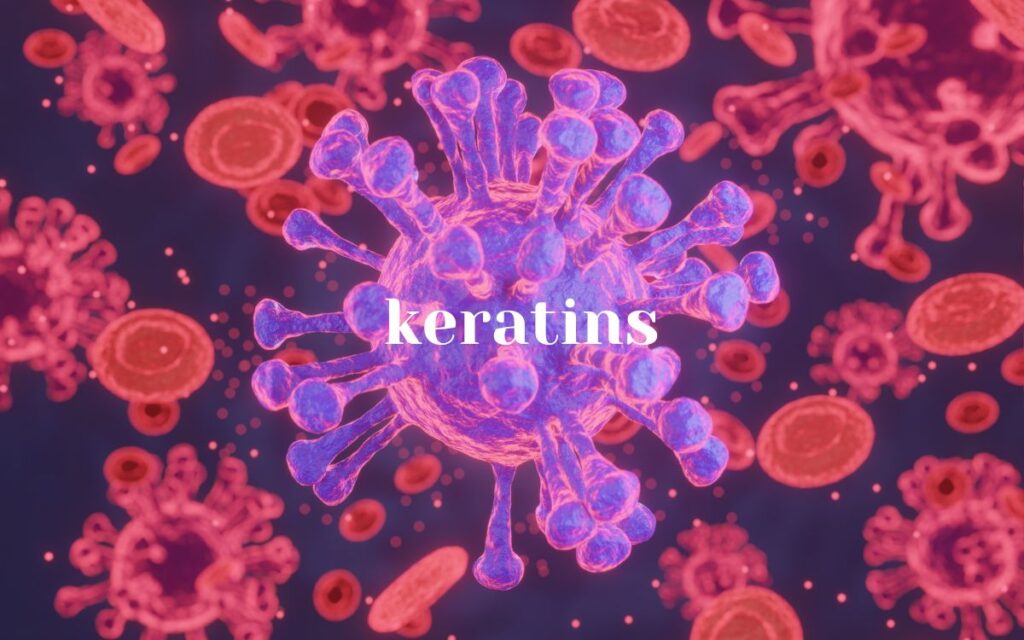Keratin is a protein that’s important for our cells, it’s not just for hair, skin, and nails. Keratin helps build the framework of epithelial cells. These cells protect the surfaces and linings inside our body. Keratin belongs to a group of proteins called intermediate filament proteins. It gives cells strength and toughness. This helps cells handle the challenges of everyday life. From the outer layer of our skin to hair follicles and nails, keratin fibers form a strong barrier. It shields our tissues from drying out, germs, and harmful things.
Keratin is a crucial protein found in our bodies. It does more than just protect us. It also helps cells change into different types. This is very important for the growth and working of our tissues and organs. Learning about keratin shows us how complex life is at the smallest levels. This article will explore the many roles of keratin. We’ll look at how it gives structure, helps cells develop, shields tissues, and prevents disease.
What is keratins?
Keratins are special proteins. They are found in cells that cover the body’s surfaces and linings. These proteins are strong and fibrous. Their job is to provide support and protection to the cells and tissues they are in. Keratins form a network inside the cells. This network is like a skeleton that makes the cells sturdy. It allows the cells to withstand pressure, stretching, and damage from outside. The keratin network helps keep tissues whole and working properly as barriers.
Keratins are very important proteins found in body parts that face stress, like skin, hair, and nails. In the outermost layer of skin, called the epidermis, skin cells called keratinocytes make keratin proteins. These proteins form a waterproof barrier that protects the deeper tissues. It stops water loss and blocks harmful things like germs and toxins from getting inside.
Also, the body controls keratin production carefully as cells develop and specialize. This helps creates different tissues with unique roles. Different types of keratin proteins are found in different tissues and cells. Their special roles help maintain structure and perform specific jobs. In summary, keratins are very important parts of cells. They play a big role in keeping tissues strong, functional, and protected throughout the body. Without keratins, many body parts would not work properly.
Structural Integrity and Support
Keratin does an important job in making cells and tissues strong. In cells that cover surfaces, keratin makes a tight net inside the cell that supports its structure. This strong framework allows cells to handle pressure, stretching, and damage from outside without breaking apart. This helps keep tissues and barriers intact.
Keratin Helps Protect Our Body
Keratin is more than just support. It shields us from environmental threats, bringing a sense of happiness knowing we are protected. In the outermost skin layer, keratinocytes make keratin proteins. These form a waterproof barrier. This barrier protects tissues below from drying out, contributing to our overall happiness by maintaining our body’s balance. It also stops germs, toxins, and harmful things from getting in. Maintaining this barrier is crucial for keeping our body balanced. It defends against outside dangers too, allowing us to feel happiness in our safety.
Keratin Helps Cells Develop

Cells carefully control keratin production as they mature. As cells take on roles, their keratin patterns change. This diversity in keratin helps tissues function properly. For example, skin cells differentiate into layers. Each layer makes unique keratin versions. These special keratins aid in barrier formation and protection for that layer’s job.
Tissues like skin, hair, and nails need strength.
They face forces that could damage them. Keratin is a key protein that makes these tissues strong and flexible. The way keratin fibers line up inside cells allows tissues to stretch, squish, and bend without breaking. Keratin helps skin, hair, and nails stay in good shape even when stressed.
Hair and nails
Hair grows from tiny pockets in the skin called follicles. Special skin cells in follicles make keratin proteins. These proteins knit together to build hair strands. The keratin pattern in hair affects its strength, stretchiness, and feel. Everyone’s keratin patterns are a bit unique, giving each person their own hair texture.
Nails are made of keratin cells packed tightly. This makes nails strong and hard. They protect your fingertips. Nails help you grab and hold things. The keratin in nails gives them stiffness and power.
Keratin Helps Heal Wounds
Keratin plays a big part in healing wounds and repairing tissue. When you get hurt, skin cells called keratinocytes grow and move to cover the wound. They form a protective layer to stop the infection and help new tissue grow back. The keratin filaments in these moving cells provide structure and direction, assisting in covering the wound site with new skin cells and restoring the tissue.
Disease Implications
Problems with how keratins work or are made can cause big health issues. Changes in keratin genes can lead to keratinopathies. These diseases affect the skin, hair, nails, and other tissues. An example is epidermolysis bullosa, where blisters form on the skin. Ichthyosis is another issue, causing very dry, scaly skin. Immune system problems like psoriasis and autoimmune blistering diseases attack keratinocytes. This causes swelling, tissue damage, and problems with skin’s protective barrier. Learning how keratin issues cause disease helps find better treatments. New therapies can ease symptoms and improve patients’ lives.
Conclusion:
Keratins are very important proteins in our cells. They work as strong pillars that hold cells together. Keratins are mostly found in cells that cover surfaces, called epithelial cells. These proteins make cells strong and protect them from damage. Keratins form tough layers on our skin, hair, and nails. This helps guard against harm. Keratins also control how cells grow and change into different types. Thanks to keratins, our bodies can have many kinds of tissues and organs that work properly.
Learning about keratins shows how complex and well-designed our cells are. Keratins help keep us healthy by strengthening and safeguarding our bodies. Keratins are like bodyguards for our cells. They protect us from outside dangers. But they also help important jobs inside our cells. Understanding keratins teaches us how cells work. This knowledge is useful for skin care products. It also helps us learn about diseases and staying healthy.
Also Read: A Mega Guide of Blue Roses |2024
FAQ’S
What type of protein is keratin?
Keratin is a type of protein. It is a structural protein called an intermediate filament protein. These proteins look like fibres. Keratin gives strength and flexibility to cells and tissues in the body.
What is keratin used for?
Keratin has important jobs in the body. It gives strength and protection to tissues, especially in the outer layer of skin, hair, and nails. Keratin also helps form feathers, horns, scales, and claws in animals. In people, keratin keeps the outer layer of skin strong. It creates a waterproof barrier to protect against damage from the environment.
What is made of keratin?
Keratin is an important part of many body structures. It forms hair by arranging keratin cells in strands. Along with hair, keratin makes the outer layer of skin. This layer gives skin its strength and durability. Also, keratin is present in nails, feathers, horns, scales, and claws. It provides stiffness and protection to these special tissues in different living beings.







Leave a Reply